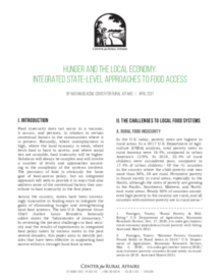Food insecurity does not occur in a vacuum; it occurs, and persists, in relation to certain contextual factors in the communities where it is present. Naturally, where unemployment is high, where the local economy is weak, where fresh food is hard to access, and where social ties are unstable, food insecurity will be higher. Solutions will always be complex and will involve a number of levels and approaches according to the complexity of the systems involved. The provision of food is obviously the basic goal of food-access policy, but an integrated approach will seek to provide it in ways that also address some of the contextual factors that contribute to food insecurity in the first place.
Across the country, states have been increasingly innovative in finding ways to integrate the goals of eliminating hunger and strengthening local food systems. The late U.S. Supreme Court Chief Justice Louis Brandeis famously called states the “laboratories of democracy.” In reviewing the present challenges to food security and the results of experiments in integrated food policy taken by various states in the past several decades, this paper aims to identify policies that have been effective in supporting food access within a stronger local food system.


